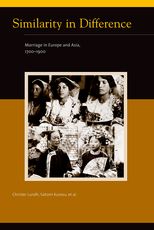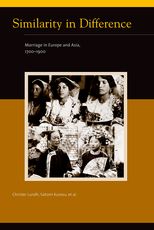Similarity in Difference: Marriage in Europe and Asia, 1700-1900
Similarity in Difference: Marriage in Europe and Asia, 1700-1900
Cite
Abstract
Since Malthus, the great contrast between Europe (England) and Asia (China) in marriage patterns and mechanisms, and household formation and family systems has been underlined by demographers and anthropologists. In Europe, late marriages, high celibacy rates, preventive checks, individualism – in Asia, early marriages, universal marriage, positive checks, parental authority (e.g. Malthus, Hajnal, Wrigley/Schofield, Macfarlane, Wolf, Skinner). This book challenges the rhetoric of an East-West dichotomy in marriage patterns and mechanisms, because it implies a picture that is too simplistic, based mainly on studies of social norms and aggregate statistics. This book argues for the EAP approach to the study of pre-industrial marriage: comparison of local populations in Asia (China, Japan) and Europe (Belgium, Italy, Sweden) for which individual-level longitudinal data are available, using the same framework, models and methods of analysis (event history analysis). In relation to the East-West binary, the EAP findings confirm the previous picture of general differences in marriage pattern and family system. However, when studied at the individual-level, great similarity in human behavior across study populations was found. For some variables effects were universal (sex, age, duration of widowhood), while for others effects indicated similarity given the differences in family systems. Little support was found for the existence of a Malthusian preventive check exclusive for Europe: there was no marriage response to fluctuation in food prices in the lower socioeconomic status groups in the European locations, and individuals from more prosperous families married earlier in all study populations.
-
Front Matter
-
I Introduction
-
II Comparative Demographies
-
4
The Roads to Reproduction: Comparing Life-Course Trajectories in Preindustrial Eurasia
Martin Dribe and others
-
5
The Influence of Economic Factors on First Marriage in Historical Europe and Asia
Tommy Bengtsson
-
6
Remarriage, Gender, and Rural Households: A Comparative Analysis of Widows and Widowers in Europe and Asia
Satomi Kurosu and others
-
4
The Roads to Reproduction: Comparing Life-Course Trajectories in Preindustrial Eurasia
-
III Local Histories
-
7
Social Norms and Human Agency: Marriage in Nineteenth-Century Sweden
Martin Dribe andChrister Lundh
-
8
Prudence as Obstinate Resistance to Pressure: Marriage in Nineteenth-Century Rural Eastern Belgium
Michel Oris and others
-
9
Between Constraints and Coercion: Marriage and Social Reproduction in Northern and Central Italy in the Eighteenth and Nineteenth Centuries
Renzo Derosas and others
-
10
Economic and Household Factors of First Marriage in Two Northeastern Japanese Villages, 1716–1870
Noriko O. Tsuya andSatomi Kurosu
-
11
Categorical Inequality and Gender Difference: Marriage and Remarriage in Northeast China, 1749–1913
Shuang Chen and others
-
7
Social Norms and Human Agency: Marriage in Nineteenth-Century Sweden
-
IV Conclusion
-
End Matter
Sign in
Personal account
- Sign in with email/username & password
- Get email alerts
- Save searches
- Purchase content
- Activate your purchase/trial code
Institutional access
-
Sign in through your institution
- Sign in with a library card Sign in with username/password Recommend to your librarian
Institutional account management
Sign in as administratorPurchase
Our books are available by subscription or purchase to libraries and institutions.
Purchasing information| Month: | Total Views: |
|---|---|
| November 2022 | 7 |
| November 2022 | 1 |
| February 2023 | 1 |
| April 2023 | 1 |
| May 2023 | 1 |
| May 2023 | 9 |
| June 2023 | 8 |
| August 2023 | 1 |
| November 2023 | 1 |
| January 2024 | 4 |
| January 2024 | 3 |
| January 2024 | 1 |
| March 2024 | 1 |
| April 2024 | 1 |




Get help with access
Institutional access
Access to content on Oxford Academic is often provided through institutional subscriptions and purchases. If you are a member of an institution with an active account, you may be able to access content in one of the following ways:
IP based access
Typically, access is provided across an institutional network to a range of IP addresses. This authentication occurs automatically, and it is not possible to sign out of an IP authenticated account.
Sign in through your institution
Choose this option to get remote access when outside your institution. Shibboleth/Open Athens technology is used to provide single sign-on between your institution’s website and Oxford Academic.
If your institution is not listed or you cannot sign in to your institution’s website, please contact your librarian or administrator.
Sign in with a library card
Enter your library card number to sign in. If you cannot sign in, please contact your librarian.
Society Members
Society member access to a journal is achieved in one of the following ways:
Sign in through society site
Many societies offer single sign-on between the society website and Oxford Academic. If you see ‘Sign in through society site’ in the sign in pane within a journal:
If you do not have a society account or have forgotten your username or password, please contact your society.
Sign in using a personal account
Some societies use Oxford Academic personal accounts to provide access to their members. See below.
Personal account
A personal account can be used to get email alerts, save searches, purchase content, and activate subscriptions.
Some societies use Oxford Academic personal accounts to provide access to their members.
Viewing your signed in accounts
Click the account icon in the top right to:
Signed in but can't access content
Oxford Academic is home to a wide variety of products. The institutional subscription may not cover the content that you are trying to access. If you believe you should have access to that content, please contact your librarian.
Institutional account management
For librarians and administrators, your personal account also provides access to institutional account management. Here you will find options to view and activate subscriptions, manage institutional settings and access options, access usage statistics, and more.